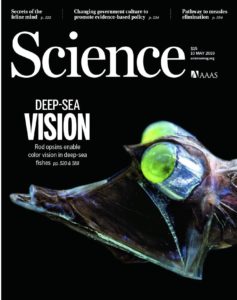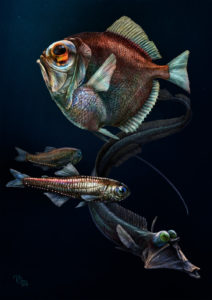Silver spinyfins (Diretmus argenteus) live in the deep-sea and have extremely adapted “super-vision” with 38 rhodopsin genes in their genome.
Our recent study was published in Science including the cover page.
We found three lineages of deep-sea fishes with duplications of rod opsin genes (rhododpsins RH1) with two species of Diretmidae (Teleostei: Trachichthyiformes) possessing 38 and 20 copies of rhodopsin RH1 each, the tube-eye fish (Stylephorus chordatus; Stylephoriformes) have six RH1 copies, and lanternfishes (Myctophiformes) possess five copies of RH1 in their genome. This adaptation to vision in the dark evolved several times independently. The exact mechanism of this vision remains elusive as so far no other vertebrate is known to have more than two rod opsin genes in the genome (and therefore in the rod cells in retina).
Our study also reached wide international attention in more than 100 international newspapers, journals, webpages etc., including The New York Times, The Independent, New Scientist, The Scientist, Forbes, Discover magazine, Le Monde (in French)…
Article reference: Musilová, Z., Cortesi, F., Matschiner, M., Davies, W. I., Patel, J. S., Stieb, S. M., … & Salzburger, W. 2019. Vision using multiple distinct rod opsins in deep-sea fishes. Science. 364 (6440), 588-592.
Featured on the Science webpage here.
Beautiful deep-sea drawing including three species with enhanced vision was provided by Pavel Říha from University of South Bohemia, Czech Republic:
From top: silver spinyfin Diretmus argenteus (Teleostei: Trachichthyiformes), two individuals of glacier lanternfish Benthosema glaciale (Teleostei: Myctophiformes) and tube-eye Stylephorus chordatus (Teleostei: Stylephoriformes)

